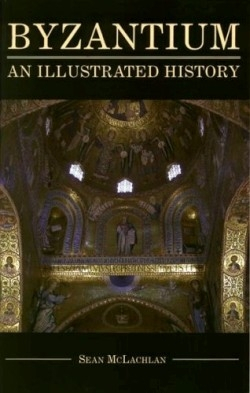
Byzantium
An Illustrated History
Arguably, the third most important event in the history of Christianity—after the resurrection and Saul’s vision on the road to Damascus—occurred when Constantine, the founder of Constantinople, had a vision of a cross before a battle in 324 A.D. He won the battle, became the emperor or Rome, and converted to Christianity. More importantly, he declared the Christian faith to be the new favored religion of the Roman Empire. Christianity was transformed from a persecuted sect to the basis of Western civilization.
When Constantine won sole rule of the entire Roman Empire, he quickly began the building of Constantinople, capital of the Byzantium Empire. It replaced Rome as the capital of a unified empire in 330 and remained so until the death of Theodosius sixty years later. The Visigoths sacked Rome in 410 and although Western emperors continued sporadically to rule in Rome until 476, Constantinople became the de facto center of the Roman Empire and civilization for nearly a thousand years. This volume, suitable for high school students and curious adult readers, offers a brief history of Byzantium, an empire generally given short shrift in high school and college histories of Western civilization.
This is the author’s second book; his first was a travel guide to Phoenix in the popular Insider’s Guide series. With a master’s degree in archaeology, specializing in medieval times, he has written extensively on travel, archaeology, history, architecture, and religion for popular magazines and scholarly journals.
McLachlan relates the story chronologically, using the dynasties of the Byzantium emperors as the structure for his text. While the military aspects of the empire are given the most attention, religious events, the economy, and social movements are well represented. With today’s headlines on the Middle East, the history of Byzantium’s interaction with Islam and the Crusades will be of great interest. Unfortunately for an illustrated history, the illustrations are poor photographs and bear little relationship to the content of the book. A gazetteer of monuments, timeline, and list of emperors provides helpful supplements to the text.
The Byzantium Empire was the depository of culture, art, and knowledge for Western civilization from the decline of Rome to the rise of the Italian states in the early Renaissance. It was the home of Orthodox Christianity and many of the major ecumenical councils that determined Christian doctrine. This book fills the need for a capsule history of this neglected empire.
Reviewed by
Paul Deane
Disclosure: This article is not an endorsement, but a review. The publisher of this book provided free copies of the book to have their book reviewed by a professional reviewer. No fee was paid by the publisher for this review. Foreword Reviews only recommends books that we love. Foreword Magazine, Inc. is disclosing this in accordance with the Federal Trade Commission’s 16 CFR, Part 255.
